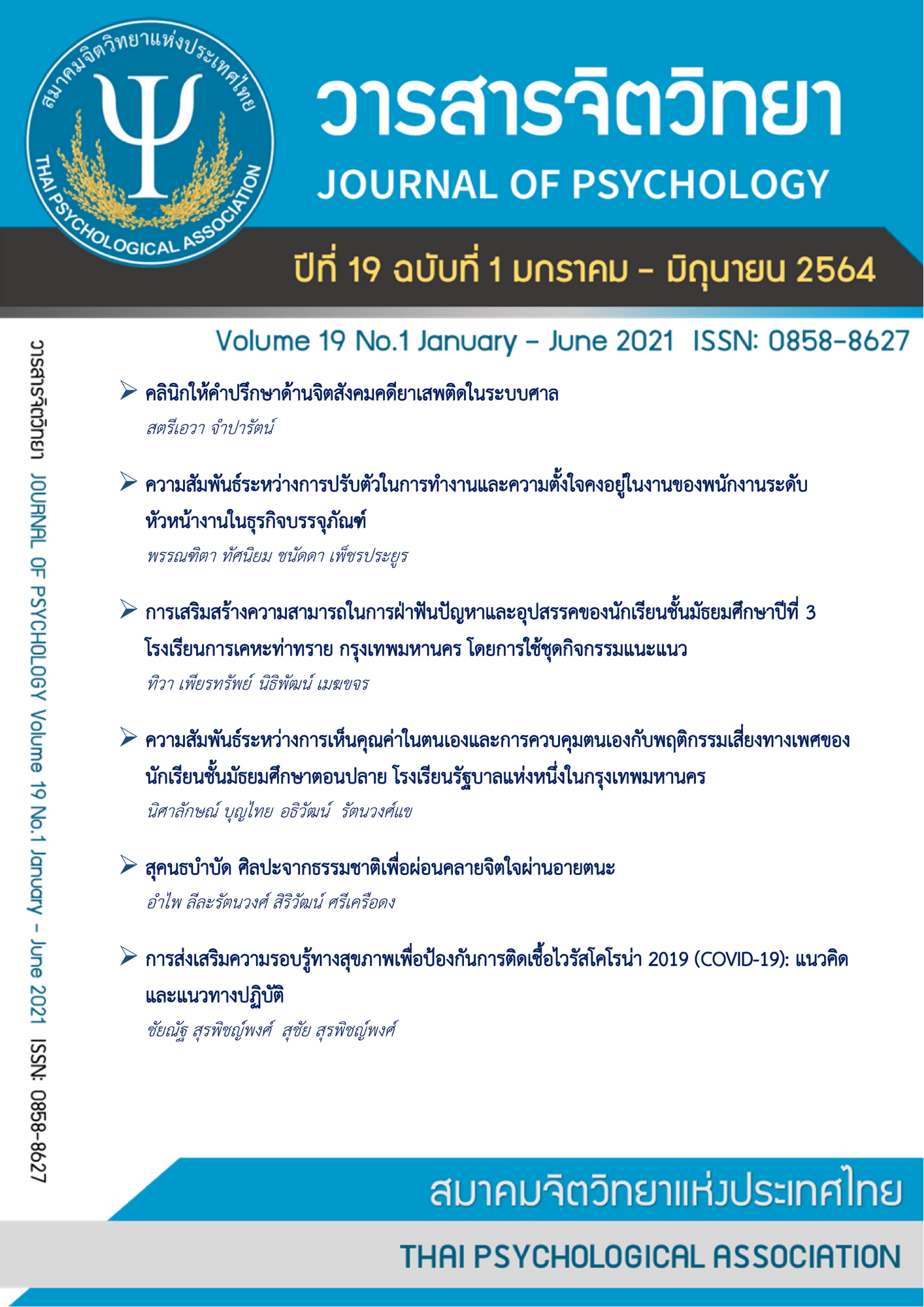สุคนธบำบัด ศิลปะจากธรรมชาติเพื่อผ่อนคลายจิตใจผ่านอายตนะ
คำสำคัญ:
สุคนธบำบัด, อายตนะ, ศิลปะจากธรรมชาติบทคัดย่อ
บทความวิชาการนี้มีวัตถุประสงค์ เพื่อศึกษาและรวบรวมข้อมูลเกี่ยวกับการบำบัดด้วยวิธีธรรมชาติซึ่งเป็นภูมิปัญญาที่มีมาแต่สมัยโบราณเมื่อหลายพันปี ก่อนการแพทย์สมัยใหม่จะมีบทบาทเหมือนเช่นปัจจุบัน เน้นการศึกษาถึงที่มาของการใช้น้ำมันหอมระเหย วิวัฒนาการ และการนำไปใช้ตั้งแต่อดีตจนถึงปัจจุบัน ศึกษาข้อมูลของชนิด รูปแบบ และหลักการทำงานของน้ำมันหอมระเหยต่อระบบสมองในการช่วยผ่อนคลายภาวะต่าง ๆ เช่น ภาวะซึมเศร้า และช่วยผ่อนคลายความเมื่อยล้า เพื่อนำมาหาความเป็นไปได้ในการนำมาใช้แทนการรักษาด้วยยา ซึ่งก่อให้เกิดผลข้างเคียงต่อผู้รับการรักษา สอดคล้องกับทางพุทธศาสนา ได้เปรียบการรับรู้ความทุกข์และสิ่งต่าง ๆ รอบตัวผ่าน อายตนะ ซึ่งตรงกับประสาทสัมผัสทั้ง 5 เช่นกัน การนำ Aromatherapy มาใช้ผ่านประสาทสัมผัสต่าง ๆ โดยเฉพาะ “คันธะ” หรือทางการสูดดม ซึ่งเป็นวิธีที่ได้ผลและสามารถนำมารักษาผู้ป่วยที่มีอาการซึมเศร้าได้ ดังนั้น อโรม่าเทอราพี จึงสามารถนำมาเป็นทางเลือกในการบำบัดรักษาโรคซึมเศร้าในผู้ป่วยได้ สามารถนำมาเป็นทางเลือกทางการแพทย์ ที่มีต้นทุนไม่สูงและสามารถนำไปใช้ได้อย่างต่อเนื่อง เนื่องจากเป็นวิธีทางธรรมชาติ
References
จำรัส เซ็นนิล. (2546). “หอมระเหย...ศาสตร์แห่งการบำบัด”. กรุงเทพฯ : มรดกสยาม.
ดุษฎี อุดมอิทธิพงศ์, กฤตนัย แก้วยศ, และเกยูรมาศ อยู่ถิ่น. (2561). “น้ำมันหอมระเหยกับการทำงานของระบบ
ประสาทและความรู้สึกทางอารมณ์”. วารสารสถาบันจิตเวชศาสตร์สมเด็จเจ้าพระยา. 12 (2), 51-52.
ไทยเกษตรศาสตร์. (2011). 12 วิธีการใช้ประโยชน์จากน้ำมันหอมระเหย. สืบค้น 5 มีนาคม 2564 จาก
https://www.thaikasetsart.com/12-วิธีการใช้ประโยชน์จาก/
นิภา จันทิชัย. (2560). “การสู่ขวัญในประเทศไทย”. (วิทยานิพนธ์ศิลปศาสตรมหาบัณฑิตบัณฑิต สาขาวิชาภาษา
และวรรณกรรมไทย). มหาวิทยาลัยราชภัฎมหาสารคาม.
พงษ์ศักดิ์ จิตตบุตร และคณะ. (2562). ระบบการสกัดน้ำมันหอมระเหยจากพืชสมุนไพรโดยใช้แกลบเป็นเชื้อเพลิง.
วารสารวิทยาศาสตร์และเทคโนโลยี. 4(2), 67
ไพบูลย์ เทวรักษ์. (2532). จิตวิทยา ศึกษาพฤติกรรมภายนอกและภายใน. (พิมพ์ครั้งที่ 2). กรุงเทพมหานคร:
ศรีมงคลการพิมพ์.
มหาวิทยาลัยมหาจุฬาลงกรณราชวิทยาลัย. (2539). พระไตรปิฎกภาษาไทย ฉบับมหาจุฬาลงกรณราชวิทยาลัย.
กรุงเทพมหานคร: โรงพิมพ์มหาวิทยาลัยมหาจุฬาลงกรณราชวิทยาลัย.
รุจินาถ อรรถสิษฐ. (2548). ขวัญ : ขวัญชีวิตของคนไทย. นนทบุรี: กรมพัฒนาการแพทย์แผนไทยและ การ
แพทย์ทางเลือก กระทรวงสาธารณสุข.
เศรษฐศาสตร์ วัตรโศก. (2020). ขวัญ กับความเชื่อของชาวอีสาน. สืบค้น 10 มีนาคม 2564 จาก
https://theisaanrecord.co/2020/10/23/spirit-and-belief-in-isaan/
สมเด็จพระพุทธโฆษาจารย์. (2561). พจนานุกรมพุทธศาสตร์ฉบับประมวลธรรม. (พิมพ์ครั้งที่ 41).
กรุงเทพมหานคร: สำนักพิมพ์ผลิธัมม์.
สมเด็จพระสังฆราช สกลมหาสังฆปริณายก. สัมมาทิฏฐิ 37 อายตนะเป็นปัจจัยให้เกิดผัสสะ. สืบค้น 17 มกราคม
จาก https://sites.google.com/site/smartdhamma/xaytna-pen-paccay-hi-keid-phass-a
สารานุกรมไทยสำหรับเยาวชน. บายศรีภาคเหนือ. สืบค้น 10 มีนาคม 2564 จาก
https://www.saranukromthai.or.th/sub/book/book.php?book=38&chap=2&page=t38-2-
infodetail05.html
อารยธรรมคนลุ่มแม่น้ำโขง. (2559). การส่อนขวัญ. สืบค้น 10 มีนาคม 2564 จาก
http://ourmaekong.blogspot.com/2016/09/blog-post_6.html
อิงอร จุลทรัพย์. (2556). “บททำขวัญ : วิถีคนสยามในมาเลเซีย”. วารสารปาริชาต. 25(2), 54.
อุมารินทร์ ตุลารักษ์. (2544). บททำขวัญเรือและพิธีทำขวัญเรือของชายไทยภาคใต้ : การสร้างสรรค์และการ
ถ่ายทอด. (วิทยานิพนธ์อักษรศาสตร์มหาบัณฑิต ). จุฬาลงกรณ์มหาวิทยาลัย.
AromaWeb. “History of Aromaterapy”. Retrieved March 10, 2021 from
https://www.aromaweb.com/articles/history.asp
Health. (2019). รู้ลึก 7 กลิ่นหอมจาก "น้ำมันหอมระเหย" บำบัดสุขภาพกายใจ". สืบค้น 5 มีนาคม 2564 จาก
https://www.thairath.co.th/women/beauty/health/1534693
Marlynn Wei M.D., J.D. (2016). Six Aromatherapy Essential Oils for Stress Relief and Sleep.
Retrieved April 2, 2021 from https://www.psychologytoday.com/us/blog/urban-
survival/201604/six-aromatherapy-essential-oils-stress-relief-and-sleep
Mayo clinic, Depression Treatment. Retrieved April 2, 2021 from
https://www.mayoclinic.org/diseases-conditions/depression/diagnosis-treatment/drc-
Rama Channel. (2018). จมูกไม่ได้กลิ่นความผิดปกติที่คุณอาจเป็นได้. สืบค้น 5 มีนาคม 2564 จาก
https://www.rama.mahidol.ac.th/ramachannel/article/ จมูกไม่ได้กลิ่น-ความผิด/
Sánchez-Vidaña, D. I., Ngai, S. P. C., He, W., Chow, J. K. W., Lau, B. W. M., & Tsang, H. W. H.
(2017). "The Effectiveness of Aromatherapy for Depressive Symptoms: A Systematic
Review", Evidence-Based Complementary and Alternative Medicine, vol. 2017, 21.
https://doi.org/10.1155/2017/5869315
The American Psychiatric Association (APA) (2020), “What is depression”. Retrieved March 5,
from https://www.psychiatry.org/patients-families/depression/what-is-depression
Valencia Higuera. (2020). Everything You Want to Know About Depression. Retrieved March 5,
from https://www.healthline.com/health/depression
Urban Creature. (2019). กลิ่นของความรัก กลิ่นของความหวัง กลิ่นของความทรงจำ. สืบค้น 10 มีนาคม 2564
เผยแพร่แล้ว
How to Cite
ฉบับ
บท
License
Copyright (c) 2021 สมาคมจิตวิทยาแห่งประเทศไทย

This work is licensed under a Creative Commons Attribution-NonCommercial-NoDerivatives 4.0 International License.
บทความที่ได้รับการตีพิมพ์เป็นลิขสิทธิ์ของสมาคมจิตวิทยาแห่งประเทศไทย
ข้อความที่ปรากฎในบทความแต่ละเรื่องในวารสารวิชาการเล่มนี้เป็นความคิดเห็นส่วนตัวของผู้เขียนแต่ละท่านไม่เกี่ยวข้องกับสมาคมจิตวิทยาแห่งประเทศไทย แต่อย่างใด ความรับผิดชอบองค์ประกอบทั้งหมดของบทความแต่ละเรื่องเป็นของผู้เขียนแต่ละท่าน หากมีความผิดพลาดใด ๆ ผู้เขียนแต่ละท่านจะรับผิดชอบบทความของตนเองแต่ผู้เดียว





